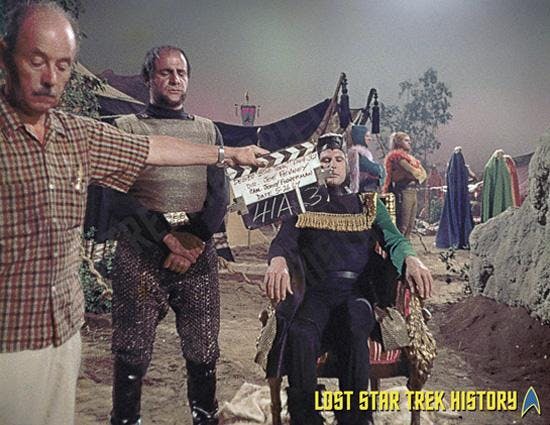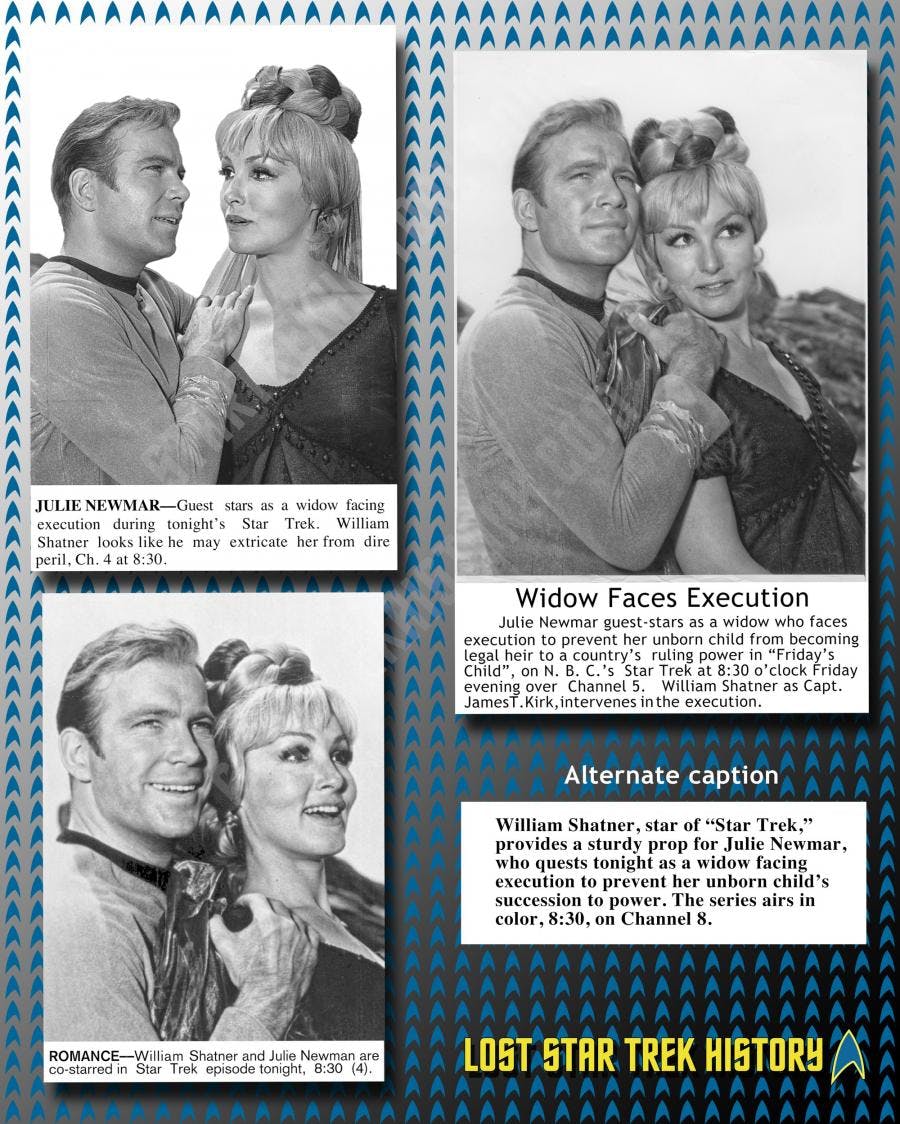Star Trek: Enterprise
Published Nov 30, 2017
"Friday's Child" 50 Years Later
By
David Tilotta and Curt McAloney
“Friday’s Child," the 40th aired episode of Star Trek: The Original Series, concerned the Enterprise’s mission on Capella IV, a planet inhabited by nomadic tribes, to secure mining rights to an important mineral. That mission is greatly complicated, however, by two Kirk realizations: the Klingons also want the mineral rights and the pregnant widow of the murdered tribal High Leader with whom he started negotiating needs protecting.
It’s hard to believe, but “Friday’s Child” was born on network television 50 years ago today. Here’s a brief look at some of the events that led to its gestation and birth.
Conception
“Friday’s Child” was written by story editor Dorothy (D.C.) Fontana. She penned it because she wanted to tell a story involving a strong female character who wasn’t necessarily interested in children. The episode's title comes from an old child’s nursery rhyme that can be traced back to at least 1838. Although there are several variations of this rhyme, Fontana’s episode outline, dated January 11, 1967, opens with the version from Harper’s Weekly magazine published in 1887:
Monday's child is fair of face.Tuesday's child is full of grace.Wednesday's child is living and giving.Thursday's child works hard for a living.Friday's child is full of woe.Saturday's child has far to go.But the child that is born on the Sabbath day is grave and bonny and good and gay.
Fontana, like all writers for TOS, pitched this episode to the producers via a story outline, and the 17-page document that she wrote was fundamentally the same as what was finalized and filmed. There were some notable differences, however, including:
- Scotty accompanied Kirk, McCoy and Spock to the planet Ceres in the outline.
- A redshirt (Lieutenant Grant, Bob Bralver) was not killed in the teaser; rather, two of High Leader Akaar’s (Ben Gage’s) personal bodyguards were.
- The Enterprise was kept busy shuttling emergency medical supplies from the planet Eridani to the planet Dierdre.
- The Klingons were not present in the outline. Maab (Michael Dante) sought Akaar’s tribe and power, so he and his men were the villains.
- Akaar was killed by Maab’s assassins.
- It was Scotty, rather than Spock, who rigged the communicator “sound bomb” in the rocky defile
- Scotty assisted McCoy in delivering Eleen’s (Julie Newmar’s) baby son.
- McCoy and Scotty carried Eleen and her baby on a litter, across the countryside, to hide with Eleen’s tribe. Kirk and Spock created a diversion for them by fighting Maab’s men, who were in pursuit.
- Kirk killed Maab by handing him a phaser on overload.
- Eleen named the baby “Leonard Montgomery Akaar” to show gratitude to McCoy and Scotty for helping with her son's delivery.
Labor
Principal photography for “Friday’s Child” was done from May 19 to May 29, 1967, under the direction of Joseph Pevney. Interior scenes were shot at Desilu Studios in Hollywood, while exteriors were filmed at the Vasquez Rocks Natural Park Area in California.
One faux exterior scene that was not lensed at Vasquez was the sequence showing Kras the Klingon (Tige Andrews) attempting to convince Maab the Capellan to return his weapon. If you recall, this scene, scene 41 in the shooting script, played out at night, around a Capellan campfire, and it was filmed on the Desilu soundstage instead of at the Vasquez exterior location. The reason for this can be found in an April 20, 1967 production memo that associate producer Robert Justman wrote to producer Gene Coon:
“It is extremely important that all the scenes around the encampment at the beginning of the show be set up and played on Stage 10. Otherwise we are in for several full nights of night-for-night exteriors, which we cannot afford at all.”
The following four pictures, obtained from frames of production footage sold by Star Trek Enterprises back in the 1970s, show some aspects of how scene 41 was filmed.
Above: This image is from footage of the unused master shot of the scene filmed on the Desilu soundstage. One way you can tell this was the master is that there’s no letter following the scene number (41) on the lower left of the clapperboard held by the second assistant cameraman. A master shot of a scene is usually filmed before any of the other shots and it keeps all the actors visible once they enter the view of the camera. This type of shot is also called an establishing shot because it establishes where we are and, sometimes, when we are.
Above: This photo is from film that came from a “two-shot” – so named because it shows just two actors together - of Tige Andrews (left) and Michael Dante (right). In general, any letter following the scene number - “A” in this case - meant (and usually still means today) that the footage was acquired with the camera moved to a different position from the master shot. By the way, the number in the lower right of the clapperboard, 3 in this case, is the take number.
Above: These two frames are from film that was shot as close-ups for scene 41. The close-up footage for Michael Dante was designated “B” on the clapperboard (left picture) and that for Tige Andrews was designated as “C” (right picture). Interestingly, when this scene was assembled for the aired version, only the two-shot and the close-up of Michael Dante was used.
The Birth Announcement
“Friday’s Child was first broadcast on December 1, 1967, and it was promoted in newspapers and other media starting on the preceding week.
Above: Newspapers around the country made heavy use of the publicity photos furnished by the advertising company hired by Desilu (McFadden, Strauss, Eddy, and Irwin, MSEI). The captions these newspapers used for the photos, however, deviated significantly from what MSEI supplied. Here’s a sampling of ads, two from the December 1, 1967 Los Angeles Times (upper and lower left), one from the November 26, 1967 Seattle Times (upper right) and an additional caption used with the picture shown in the Seattle Times ad.
And with that, we’re done. We hope you’ve enjoyed our nascent look back. Until next time.





